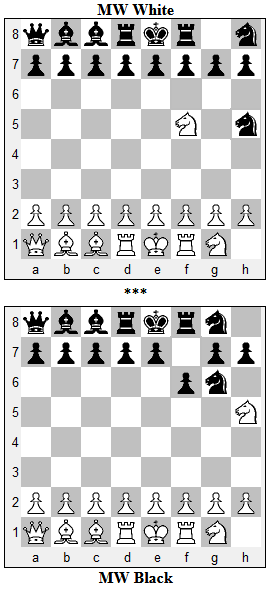At first glance, there doesn't seem to be a high correlation between the Sesse results and the CCRL results. The first position where there is agreement between the two sources is [SP868] QBBRKRNN. I once discussed this position in 'A Difficult SP for Black' (April 2013). By coincidence, I'm currently playing the position in a pair of correspondence games and hope to have more to say about it in the future.
The two games have finished, so the future is today. For easy reference, here's a link to the original post: A Difficult SP for Black. Already on the first move, White threatens a smothered mate on the third move. In that post I noted,
Black has two methods of meeting the difficult challenge posed by 1.Ng3.
Those two methods were:-
• 1...Nf6 2.Nf5 Rg8, and
• 1...g6.
Both of the latest games used different methods of defense, as shown in the diagrams below. The top diagram is my game as White. The game started with the first line above, but instead of 2...Rg8, Black played 2...Nh5, guarding the sensitive square g7. This looks like a natural move, so why didn't I consider it six years ago? I looked at my notes from that game and recalled that the move appeared only infrequently on the CCRL database, which is a record of engine-vs-engine games. Even today on the CCRL, after hundreds more games have been added for SP868, the move 2...Nh5 has not been tried very much. Why not? Either there is a tactical refutation or the engines have a built-in bias against moving a Knight to the a-or-h files. I couldn't find a tactical refutation.
The game continued 3.b3 f6 4.d4 c6 5.Nf3 d5 6.c4 Bxf5 7.Bxf5 g6 8.Bc2 Nf7, after which I castled 9.O-O. I had the initiative for most of the game, but it turned out to be insufficient. The game eventually ended in a draw after about 60 moves, with an unavoidable tablebase position on the horizon.

The bottom diagram is my game as Black. Here I was attracted by the idea of sacrificing a Pawn with 1...Ng6. The move had been played three times on CCRL with a score of +0-3=0, all wins by Stockfish as Black. A Pawn sacrifice is also the idea behind 1...g6, but is either sacrifice really playable? I spent a few hours analyzing the various continuations after 1...Ng6, and concluded that it was no worse than the alternatives. The game continued 2.Nh5 f6 (diagram) 3.c4 d5 4.f4 Nh6 5.f5 Nh4 6.Nxg7+ Kf7 7.Ne6 Ng4 8.Rf3 Bxe6 9.fxe6+ Kxe6. This might be the first game I have played where my King was on its third rank before the 10th move. Even more curiously, it turned out to be safe there. I eventually equalized and the game was drawn on the 55th move.
That makes two games, two draws, and two more ways to handle 'A Difficult SP for Black'. The two new methods are:-
• 1...Nf6 2.Nf5 Nh5, and
• 1...Ng6.
Good thing the SP is more complicated than it looks. Even one chess960 position lost from the first move would mean trouble for Fischer's greatest invention.
